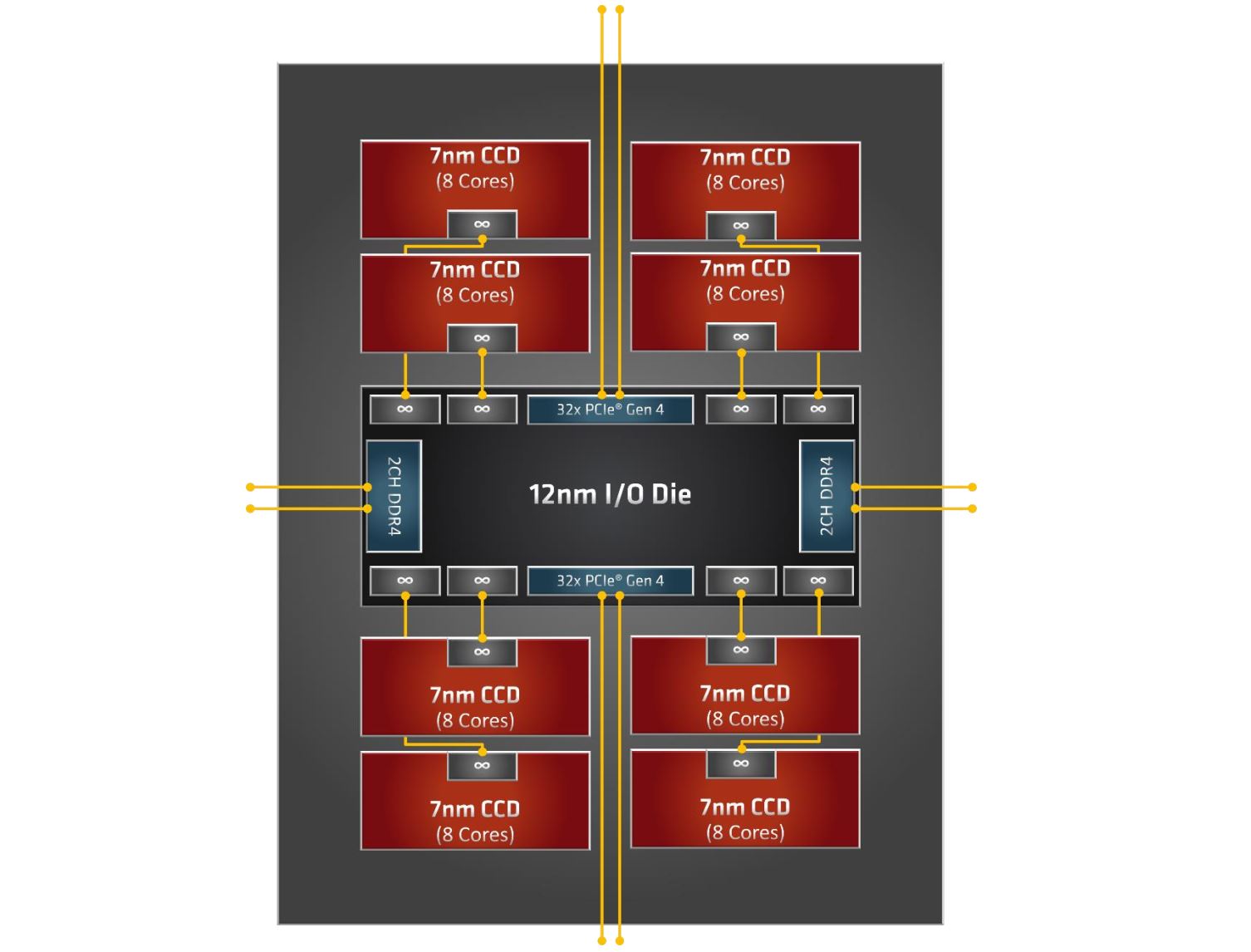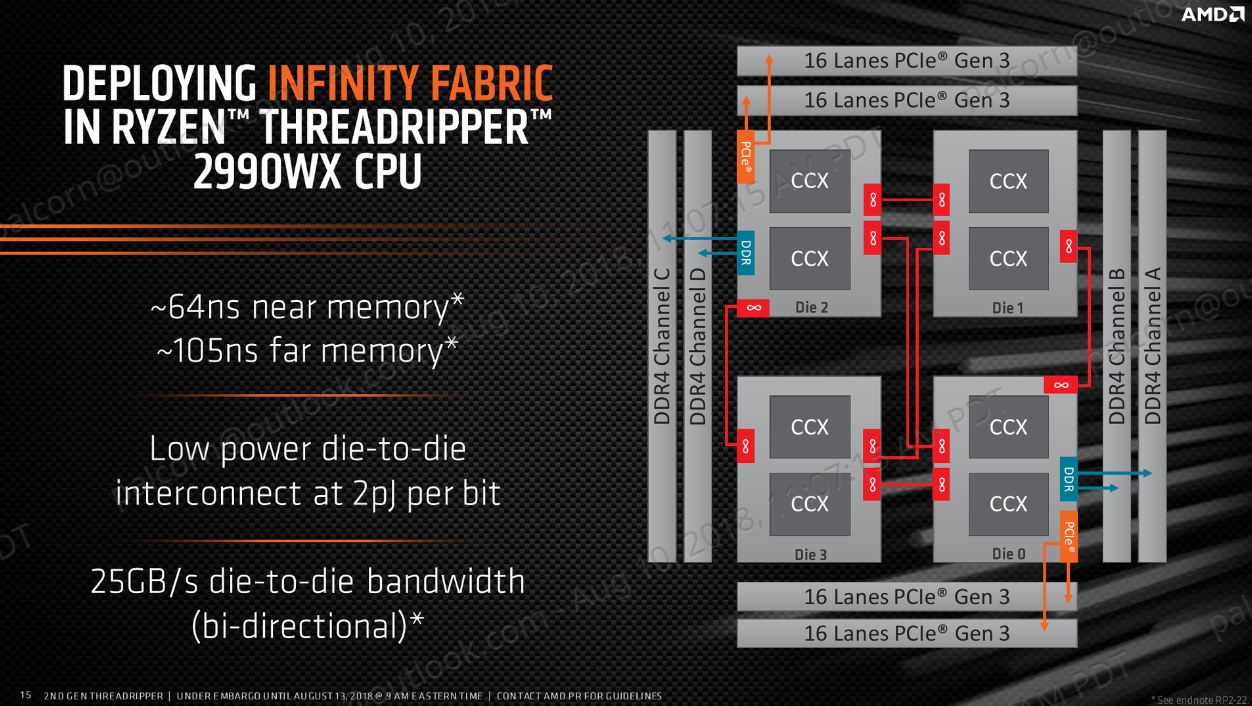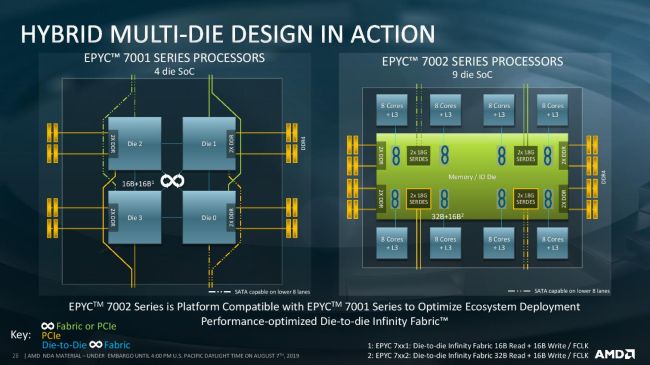Tom's Hardware Verdict
The 64-core 128-thread Threadripper 3990X is a highly-specialized processor that provides incredible performance in a narrow cross-section of workloads, but at a very attractive price point given its capabilities.
Pros
- +
Competitive per-core pricing
- +
Excellent rendering performance
- +
Overclockable
- +
Indium solder
- +
PCIe 4.0
- +
ECC support
Cons
- -
Benefits a narrow cross-section of workloads
Why you can trust Tom's Hardware
AMD says its $3,990 Threadripper 3990X offers more performance than two of Intel’s $10,009 Xeon 8280’s, but in one 64-core package for specialized applications, like Hollywood VFX rendering. Surprisingly, the new chip slots into the familiar high end desktop platform and has enthusiast-class features, like overclockability, that offer a unique value proposition.
We’re breaking out the firepower today, unleashing some of the fastest data center processors in the world to put AMD’s claims to the test, including head-to-head comparisons with a dual-socket Intel Xeon Platinum 8280 server (56C/112T), and both single- and dual-socket AMD EPYC Rome server platforms (128C/256T). We also include the relevant mainstream and HEDT competitors, too.
The first- and second-gen Ryzen chips spurred a slow shift for mainstream desktop PCs, but AMD’s fast move to the 7nm process and Zen 2 with the Ryzen 3000 chips opened up a new level of performance that caught its rival Intel flat-footed, particularly in the high-end desktop market. As a result, Intel recently ceded the upper echelons of the HEDT market to the Threadripper 3000 series and resigned itself to slashing gen-on-gen pricing on its new Cascade Lake-X models to slow AMD’s advance.
But as impressive as AMD’s inaugural third-gen Threadripper processors are, the record-setting 32-core 64-thread 3970X doesn’t represent AMD’s best effort: Today, AMD presses its advantage with the 64-core 128-thread Threadripper 3990X. The 3990X, which is based on the same design of the company’s EPYC Rome data center processors, represents AMD’s crowning achievement on the high end desktop as the company pushes core counts 3.5 times higher than Intel’s finest HEDT silicon.
But even though AMD's first 64-core x86 processor comes packing an amazing amount of horsepower, it isn’t an enthusiast-focused product. AMD’s goal is to fuse the high core counts of the EPYC Rome processors, which have the lower clock frequencies expected of a server chip, with the relatively high frequencies and enthusiast feature set, like overclockability, of high end desktop (HEDT) parts. AMD made a few other strategic adjustments to the new chips to reduce cost and keep the 3990X from encroaching on its server parts, but the end result is a threaded beast that can manhandle the toughest workloads at a comparatively attractive price point.
However, as we learned from AMD’s journey with the Ryzen processors, today’s software and operating systems still aren’t designed to fully exploit massively parallel x86 architectures, and we'll see plenty of examples of that in our testing today.
With time and effort, AMD has pushed the industry forward to more fully utilize its silicon, but that effort enters a new stage with the 3990X. As a result of multiple architectural factors, combined with the reluctant software ecosystem, the Threadripper 3990X finds itself as a specialized workhorse for the most demanding of customers in a very narrow field: the visual effects and rendering world. AMD also expects other use-cases to emerge in time, particularly as software evolves to take advantage of the chips' resources, but the 3990X already represents the best value in what is arguably a new market segment.
Get Tom's Hardware's best news and in-depth reviews, straight to your inbox.
Threadripper 3990X Specifications and Pricing
Like the other Threadripper 3000 processors, the 3990X is drop-in compatible with existing TRX40 motherboards, but you'll need to update the BIOS to unlock the best performance.
AMD laid the groundwork for the 3990X during TRX40’s design phase, so all existing motherboards can provide enough power to satiate the 280W TDP chip. As you would expect given the TDP, cooling will play a major role in how well the chip performs. AMD says you can use existing watercoolers for the 3990X, but as we'll show on the next page, you should invest in a beefy model if you want the best performance.
| Row 0 - Cell 0 | Cores / Threads | Base / Boost (GHz) | L3 Cache (MB) | PCIe | DRAM | TDP | MSRP/RCP | Price Per Core |
| Threadripper 3990X | 64 / 128 | 2.9 / 4.3 | 256 | 88 Gen 4 (72 Usable) | Quad DDR4-3200 | 280W | $3,990 | $62.34 |
| EPYC 7702P | 64 / 128 | 2.0 / 3.35 | 256 | 128 Gen 4 | Eight-Channel DDR4-3200 | 200W | $4,425 | $69.14 |
| EPYC 7442 | 64 / 128 | 2.25 / 3.4 | 256 | 128 Gen 4 | Eight-Channel DDR4-3200 | 225W | $6,950 | $108.59 |
| Xeon 8280 | 28 / 56 | 2.7 / 4.0 | 38.5 | 48 Gen 3 | Six-Channel DDR4-2933 | 205W | $10,009 | $357.46 |
| Intel W-3175X | 28 / 56 | 3.1 / 4.8 | 38.5 | 48 Gen 3 | Six-Channel DDR4-2666 | 255W | $2999 | $107.10 |
| Threadripper 3970X | 32 / 64 | 3.7 / 4.5 | *128 | 88 Gen 4 (72 Usable) | Quad DDR4-3200 | 280W | $1999 | $62.47 |
| Xeon W-3275 | 28 / 56 | 2.5 / 4.6 | 38.5 | 64 Gen3 | Six-Channel DDR4-2933 | 205W | $4,449 | $158.89 |
| Threadripper 2990WX | 32 / 64 | 3.0 / 4.2 | 64 | 64 (4 to PCH) Gen 3 | Quad DDR4-2933 | 250W | ~$1,700 | $53 |
| Threadripper 3960X | 24 / 48 | 3.8 / 4.5 | *128 | 88 Gen 4 (72 Usable) | Quad DDR4-3200 | 280W | $1,399 | $58.29 |
| Xeon W-3265 | 24 / 48 | 2.7 / 4.6 | 33 | 64 Gen 3 | Six-Channel DDR4-2933 | 205W | $3,349 | $139.54 |
| Threadripper 2970WX | 24 / 48 | 3.0 / 4.2 | 64 | 64 (4 to PCH) Gen 3 | Quad DDR4-2933 | 250W | ~$925 | ~$38.51 |
| Core i9-10980XE | 18 / 36 | 3.0 / 4.8 | 24.75 | 48 Gen 3 | Quad DDR4-2933 | 165W | $979 | $54.39 |
| Ryzen 9 3950X | 16 / 32 | 3.5 / 4.7 | 64 | 64 | Dual DDR4-3200 | 105W | $749 | $46.81 |
The 3990X is based on the EPYC Rome 7702P that is designed for single-socket servers, so it comes with the same 64 cores and 128 threads paired with an amazing 256MB of L3 and 32MB of L2 cache.
The two processors have plenty of similarities, but the difference between the two largely boils down to clock rates, memory channels, and the number of PCIe 4.0 lanes.
As we can see, the Threadripper 3990X is significantly faster with up to a 2.9 GHz base and 4.3GHz boost than the EPYC 7702P, an improvement of 900 MHz and ~1 GHz, respectively.
We typically wouldn’t expect boost clock rates to reach that high with such a core-heavy processor, but the jump comes courtesy of AMD’s innovative boost mechanism that extract the most out of the varying maximum frequencies capabilities of each core.
The 3990X's higher clock rate is a key differentiator over the EPYC Rome processors because it benefits rendering, VFX, and compilation workloads, among others. AMD is very clear that the 3990X is best suited for intense long-duration workloads, like VFX workloads that require 24-36 hours just to render one second of footage. If your render jobs typically finish in a few hours and you aren't running them 24/7, AMD recommends going with the Threadripper 3970X or 3960X.
There's a ~$2,000 price gap between the 32-core 3970X and the 64-core 3990X, not to mention the obvious gap of 32 cores. That leaves a middle ground where a 48-core model could make sense, but AMD says it has no plans for a 48-core model at this time.
Like its HEDT counterparts, the 3990X supports up to 256GB of quad-channel DDR4-3200 memory, which is a step back from EPYC's eight channels of memory support. The memory frequency support matrix varies by DIMM population and rank, and while the processor supports ECC memory, qualification is left to the motherboard vendor.
The Threadripper processors feature the same memory controllers as the Ryzen 3000 chips, so memory overclocking is simple. As per normal, you will encounter limitations with higher-capacity kits.
AMD recommends 1GB to 2GB of memory capacity per thread for optimal performance, particularly for Hollywood VFX artists, and overclocking the memory doesn't have a big impact on most target workloads, like rendering. In either case, professionals will need to make room in the budget for a capacious memory kit - 256GB is ideal. AMD recommends the eight-channel EPYC Rome platform for workloads that benefit from higher memory throughput, like computational fluid dynamics or brain neuron simulations.
The 3990X also supports 64 lanes of PCIe 4.0, which provides twice the throughput per lane of the PCIe 3.0 interface on Intel processors. Additionally, the TRX40 chipset provides 16 GB/s of throughput between the processor and the chipset, which comes courtesy of eight PCIe 4.0 lanes. In contrast, Intel supports 4 GB/s of throughput over its DMI link through the PCIe 3.0 interface.
TRX40's extra bandwidth will benefit multiple devices that hang off the TRX40 chipset, like large PCIe SSD arrays, which is also attractive to the professional crowd that often uses separate storage devices for read, write, and scratch operations.
Threadripper 3990X Architecture
The Threadripper 3990X comes packing AMD's Zen 2 microarchitecture, but AMD spreads the design across 8 eight-core 'core chiplet die' (CCD), as opposed to four CCD with the 3970X and 3960X and two with the mainstream Ryzen chips.
AMD ties the compute chiplets together via the Infinity Fabric to a large central 12nm I/O die (IOD) that houses two 32x PCIe Gen4 controllers and two dual-channel DDR4 memory controllers. However, this IOD is significantly different than the one present in the EPYC Rome 7702P, largely because AMD culled support for eight-channel memory and halved PCIe 4.0 support to 64 lanes.
The 3990X's IOD is the same as the one in the 3970X and 3960X, but AMD fused off the four additional Infinity Fabric On-Package (IFOP) units, which are used to communicate with the CCDs, on those models because they weren't needed. As with the previous models, each of the 3990X's die has its own IFOP connection to the IOD.
Each 7nm compute chiplet features ~3.9 billion transistors, while the 12nm I/O die has ~8.34 billion transistors. For the eight-CCD 3990X that yields a total of ~39.54 billion transistors spread out over an amazing ~1008 square millimeters of silicon.






The first image in the album above outlines the 3990X SoC, the second image represents the 3970X and 3960X, the third image shows the previous-gen Threadripper design, and the fourth image is of the EPYC Rome SoC design.
Memory throughput per core is a concern with only four channels of memory to spread out among 64 cores, but AMD made architectural accommodations in the Zen 2 microarchitecture to keep data on-chip, like an almost unthinkable 288MB of total cache on the 3990X, a third AGU (Address Generation Unit), and larger opcaches, among other changes, that help keep data close to the execution cores to help overcome memory bandwidth challenges.
MORE: Best CPUs
MORE: Intel & AMD Processor Hierarchy
MORE: All CPUs Content
Current page: Castle Peak's Rarified Air
Next Page Boost Speeds, Power Consumption, Test Setup
Paul Alcorn is the Editor-in-Chief for Tom's Hardware US. He also writes news and reviews on CPUs, storage, and enterprise hardware.
-
mohammed2006 Threadripper 3990X performance gape is not enough to justify it over 3970x. which i think is the one to buy.Reply -
knekker ReplyA large number of applications don't scale well with NUMA architectures, particularly with Windows, which is the operating system of choice for visual effects artists.
I work in the VFX industry, where I've been at ILM, DNEG, MPC and Cinesite that work on most of the block buster movies, and I can tell you this. Windows is definitely not the OS of choice, that would be linux.
I do however currently work at a smaller vfx studio, and they use Windows. -
Roland Of Gilead Really enjoyed that one! Great comparison of the HEDT CPU's v Server and Mainstream, the good, the bad, and the ugly!Reply
Although, I don't get the almost apologetic tone in the Gaming Test notes. Yes, we know these CPU's aren't meant for gaming, but HEDT users, I'm sure, like to down tools too and game after a hard days slog! I suspect they'd like to know, along with the majority of the community, and anyone who'd be genuinely interested in these CPU's in the first place, what kind of gaming performance they can expect (and it's pretty damn good, by all accounts! ) from them.
Anyway, including the gaming metrics is just being comprehensive. That's why I come to Tom's. Comprehensive is good. Don't resist the urge to include these benches in future comparison's. Don't mind the detractors! :D -
domih So you could run a Cassandra 21-node cluster on one PC with 21 Virtual Machines each allocated with 6 threads, keeping 2 threads for the host. With a mobo max memory of 256GB, each VM could be allocated 11GB leaving 25GB for the host. AMD enables you to have fun 🆒Reply -
Phaaze88 Reply
Would your line of work actually enjoy using the 3990X, or would it just stick with something Intel again, due to the time and money lost swapping platforms?knekker said:I work in the VFX industry, where I've been at ILM, DNEG, MPC and Cinesite that work on most of the block buster movies, and I can tell you this. Windows is definitely not the OS of choice, that would be linux.
I do however currently work at a smaller vfx studio, and they use Windows. -
bamboe Well here they did a linux test if you like itReply
https://www.phoronix.com/scan.php?page=article&item=3990x-threadripper-linux&num=1 -
rjacko01 I have also worked Framestore, ILM, MPC etc & the idea of running windows for vfx on that scale is seriously scary. I think it's fair to say 95%+ of vfx are linux, cause only a few smaller houses run windows, often with horrendous results.Reply -
derekullo Hypothetically with 256 megabytes of L3 you could also have a 128 thread monero miner.Reply
My extrapolation from the 3970X (28900 hashes/second x 2) = 57800 hashes/second x 0.9 (due to scaling not being completely linear due to lower clock speeds) = 52020 hashes per second
Putting that into a monero calculator with a 300 watt power drain for the system and 0.06 Cost per KWh we get $1,364 profit a year.
$3990 / $1364 = 2.9 years to recoup your investment.
https://www.cryptocompare.com/mining/calculator/xmr?HashingPower=52020&HashingUnit=H/s&PowerConsumption=300&CostPerkWh=0.06&MiningPoolFee=1
Comparing this to a Geforce 2080Ti we get a strangely similar 2.89 years to recoup its investment.
$1300 / $1.23 a day = 1057 days / 365 days = 2.89 years
With the 3950x clocking higher and being 35% cheaper per core it would make more sense to use 3 - 3950x in 3 separate rigs than a 3990x.